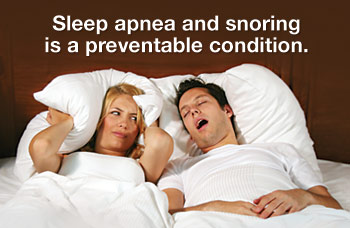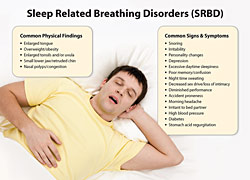Sleep Disorders & Dentistry
Not So Golden Slumbers? Learn How Your Dentist Can Help!

While sleep is an integral part of health and well-being that accounts for about a third of our lifetime, the study of sleep, sleep disorders and sleep loss is relatively new. However, here are some basics that we do know. The negative impacts of sleep loss and sleep disorders are enormous on both an individual and societal level. Children experiencing poor sleep fail to thrive and adults with this problem are to blame for some of our most devastating modern disasters, including the nuclear accident at the Three Mile Island nuclear facility, the Staten Island ferry crash, and the accidental grounding of the Exxon Valdez oil tanker. Furthermore, a 1989 seminal study on rats subjected to total sleep deprivation demonstrated death within a few weeks. And in 2006, the Institute of Medicine reported in no uncertain terms that sleep disorders and deprivation are an “unmet public health problem.” To make this point even clearer, more studies now recognize sleep disorders as reaching epidemic proportions in the U.S. with conservative numbers of around 50-70 million chronic sufferers.
These staggering facts clearly support why more and more health and dental professionals are being recruited into the study and treatment of sleep disorders. Dentists are especially important as they are in the unique position of providing limited medical therapy for patients suffering from Sleep Related Breathing Disorders (SRBD).
Sleep Medicine
The best medicine of course is to understand the problem and treat the cause — not just the symptoms. However, the exposure physicians had during their medical training up until the later part of the 20th century was primarily with rare but interesting cases such as narcolepsy (“narco” – numbness or stupor; “lepsis” – an attack or seizure) in which those afflicted literally fall soundly asleep in mid-sentence. Today, physicians can study sleep medicine, a new field of medicine that is a branch of science devoted to the study of sleep known as Somnology. It addresses the diagnosis and treatment of individuals suffering from chronic sleep loss as well as the many other sleep disorders.
“To Sleep, Perchance To Dream”
In the charming fairy tale, Sleeping Beauty, a wicked witch puts an entire kingdom to sleep, and it takes a hundred years and a magic prince to awaken it. This story for children is pure mythology — yet for adults it can inspire the questions: what is sleep, what happens during sleep, and why is it important?
Sleep is a naturally recurring state that is based on a circadian rhythm (“circa” – around; “diem” – day), upon which all life revolves. It is a state of suspended activity essential for survival and a healthy life that is characterized by a kind of unconsciousness and a decreased ability to react to stimuli.
And yet while we know these facts about sleep, it is still a mysterious phenomenon with many theories about its purpose. For example, there is a theory that the major function of sleep is to conserve energy. Another theory expounds that as the hunger mechanism is suppressed during sleep, we sleep to conserve food supplies. That means that sleep is a protective mechanism developed early in evolution. Another theory is that we are the weakest in the time of darkness, thus sleep renders us less likely to be selected as a tasty meal by nocturnal animals. Neurologically speaking, it has been theorized that our brain sensory processes are largely inactivated during sleep, giving the brain a chance to reorganize and more efficiently store the information gathered during the pre-sleep period. Apart from this, there is still a common belief that sleep helps the body to recuperate physically, enables release of growth hormone and recharges the immune (resistance) system.
What We Know
The reasons and underlying mechanisms of sleep are only partially understood and are the subject of rigorous research. The study of sleeping brain activity through electro-encephalography (EEG) better known as brain-wave activity, was first described in 1937 by Alfred Lee Loomis, but it was not until 1957 that American “father of sleep medicine,” William Dement, and sleep pioneer Nathaniel Kleitman first described the stages of sleep.
Often medical insurance will cover the cost of much of the treatments for sleep disorders.
There are two broad categories of sleep: Rapid Eye Movement (REM) and Non-Rapid Eye Movement (NREM or non-REM) sleep, each associated with bodily, brain, and psychological functions. Sleep proceeds in cycles through the night with deep sleep early on and more REM sleep toward morning (or more accurately the end of the sleep cycle). Nathaniel Kleitman, and Eugene Aserinsky coined the term, “REM,” and found that the rapid eye movements occurred periodically and in conjunction with a number of physiological (bodily) changes. As Kleitman later described it, “These changes suggested some sort of emotional disturbance, such as might be caused by dreaming.” This indeed turned out to be true. In humans, each sleep cycle lasts from 90 to 110 minutes on average and each stage may have a distinct physiological function.
 |
| Sleep Related Breathing Disorders (SRBD)
Click to enlarge |
The Big Three “Sleepers”
According to the Classification of Sleep Disorders there are eight main categories with three big hitters in terms of numbers of people affected. The big three are insomnia, sleep related breathing disorders (SRBD), and Circadian Rhythm Sleep Disorders with each occupying about one-third of the grand total. The SRBDs include conditions ranging from frequent snoring to severe Obstructive Sleep Apnea, OSA. Of all the different sleep disorders, it is OSA that is considered the most serious in terms of morbidity (state of disease) and mortality (death from disease). And it is in addressing this subgroup of disorders that dentists can play their most significant interdisciplinary role with the medical community.



